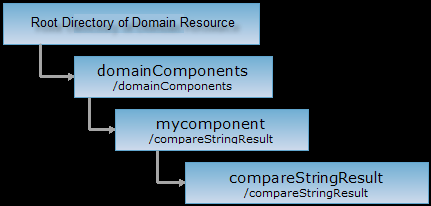
Publishing the domain service component as REST resources |
In the mechanism in which SuperMap iServer/iEdge publishes the domain component as the REST service, the methods in the domain component implementing class can be published as the REST resource.
For example, publishes the following component implementing as the REST resource:
package com.supermap.sample.DomainResource;
public class myComponent {
//Compares whether two strings are identical. Simple parameter type and returns the simple results.
public boolean compareString(String str1, String str2) {
boolean flag = true;
if (str1 != null) {
if (!str1.equals(str2)) {
flag = false;
}
} else if (str2 != null) {
flag = false;
}
return flag;
}
}
Only needs to put the Jar package after compiling this class into the directory %SuperMap iServer_HOME%/webapps/iserver/WEB-INF/lib, and adds the configuration of this component in the file services.xml in the directory %SuperMap iServer_HOME%/webapps/iserver/WEB-INF/config, as follows:
<?xml version="1.0" encoding="UTF-8"?>
<server>
...
<application>
...
<components>
...
<component name="myComponent"
class="com.supermap.sample.DomainResource.myComponent" providers="" interfaceNames="rest">
</component>
</components>
</application>
</server>
The root directory of the domain resource published as the REST service is: http://<iServer-root>/{domainComponentName}/rest. In this example usage, the root directory of the domain resource published as the REST service is:
http://localhost:8090/iserver/services/myComponent/rest
The resource structure is as follows:

An example usage URI of accessing the compareStringResult resource and getting the XML representation is:
http://localhost:8090/iserver/services/myComponent/rest/domainComponents/mycomponent/compareStringResult.xml?arg0="abc"&arg1="abc"
The response results are as follows:
<?xml version="1.0" encoding="UTF-8" standalone="no" ?>
<boolean>true</boolean>
In the domain component implementing class, all the public methods having return values will be published as resources. Different methods with different parameter types and numbers will be published as domain resources of different types (please see two domain resource types mentioned in the ResourceType enumeration in the JavaDoc document, that is, DomainArithmeticResource and DomainArithResultResource). The details are as follows.
First, we define the methods in the domain component as the simple method and the complex method:
The simple method: the parameter type is the simple type, and the parameter number is smaller than 10. The simple type includes: boolean, int, byte, short, long, double, String, char.
The complex method: the parameter type is the complex type (other types except the simple types), and the parameter number is greater than 10.

Also, we define the domain resources as simple domain resources and complex domain resources. SuperMap iServer publishes simple method in the domain component as simple domain resource, and publishes complex method as complex domain resource:
The simple domain resource: i.e. the resource of the ResourceType.DomainArithmeticResource type. The name of the simple resource is got by adding "Result" after the method name (Note: The get method is an exception. The resource name is got by deleting the parts after get of the method name and the first letter is in lowercase). The parameters of this resource are passed via the URI and result is directly returned.
The complex domain resource: i.e. the resource of the ResourceType.DomainArithResultResource type. The name of the complex resource is got by adding "Results" after the method name. The parameters of this resource are passed via the request body and the result can be got by firstly creating and then getting the result resource (i.e. first POST and then GET).
The following table lists the corresponding relations between the public method and the resource name after automatically publishing the method as the REST resource in a class:
| Public method | Description | Resource |
| void output(String s) | The methods without return values. | None. |
| String getParam() | The get method, used to get parameters. | param |
| boolean isParamNull() | The get method, used to determine whether it is null. | paramNull |
| boolean isParamNull(String s) | The general simple method (see the description of the method type). | isParamNullResult |
| String Param() | The simple method whose parameters are null, used to get the param parameter. | ParamResult |
| Point getCenter(Point, Point) | The complex method, because the parameter type is the complex type (see the description of the method type). | getCenterResults |
| boolean compareString(String, String) | The simple method (see the description of the method type).。 | compareStringResult |
| boolean isStrContainedInArray(String, String[]) | The complex method, because the parameter type is the complex type (see the description of the method type). | isStrContainedInArrayResults |
Note that when publishing the public method in the domain component as the REST resource and accessing the resource by the HTTP method, the passed parameters should use arg0, arg1, arg2 ... in turn as the parameter field names, according to the order of parameters in the original method, and the parameters are passed by means of key-value pair in the URI.
For more details of the domain spatial service extension, please see Domain Service Extensions.